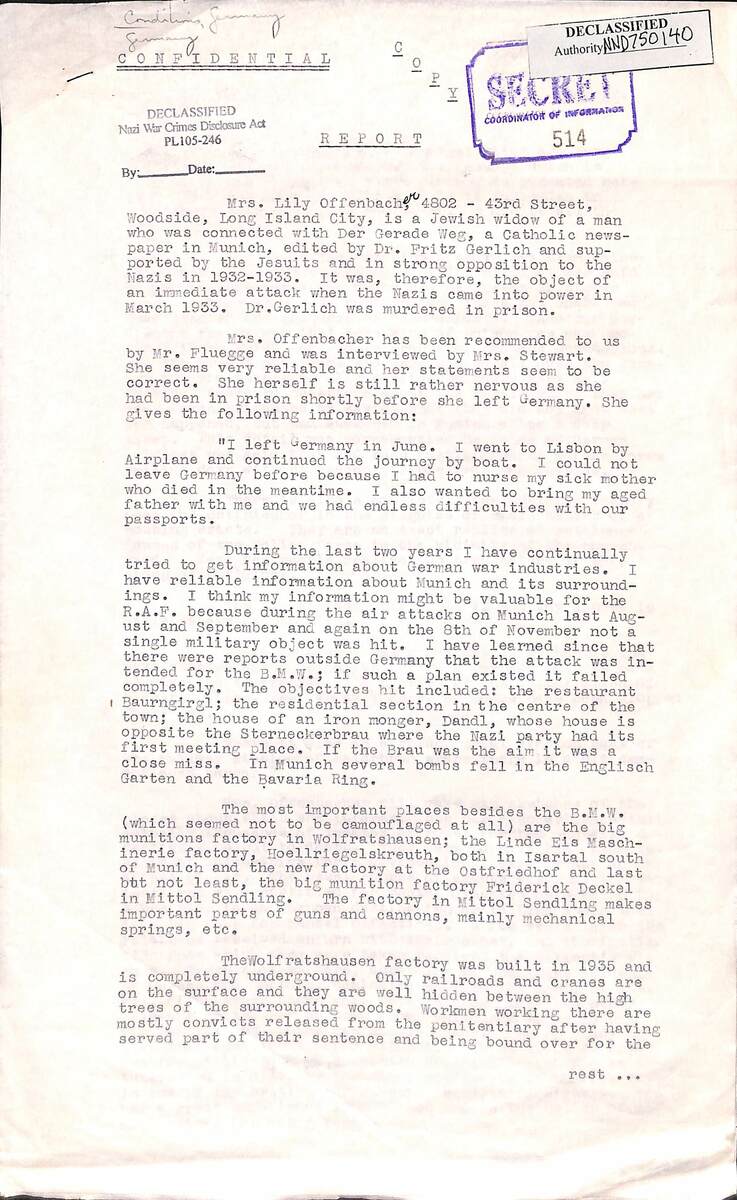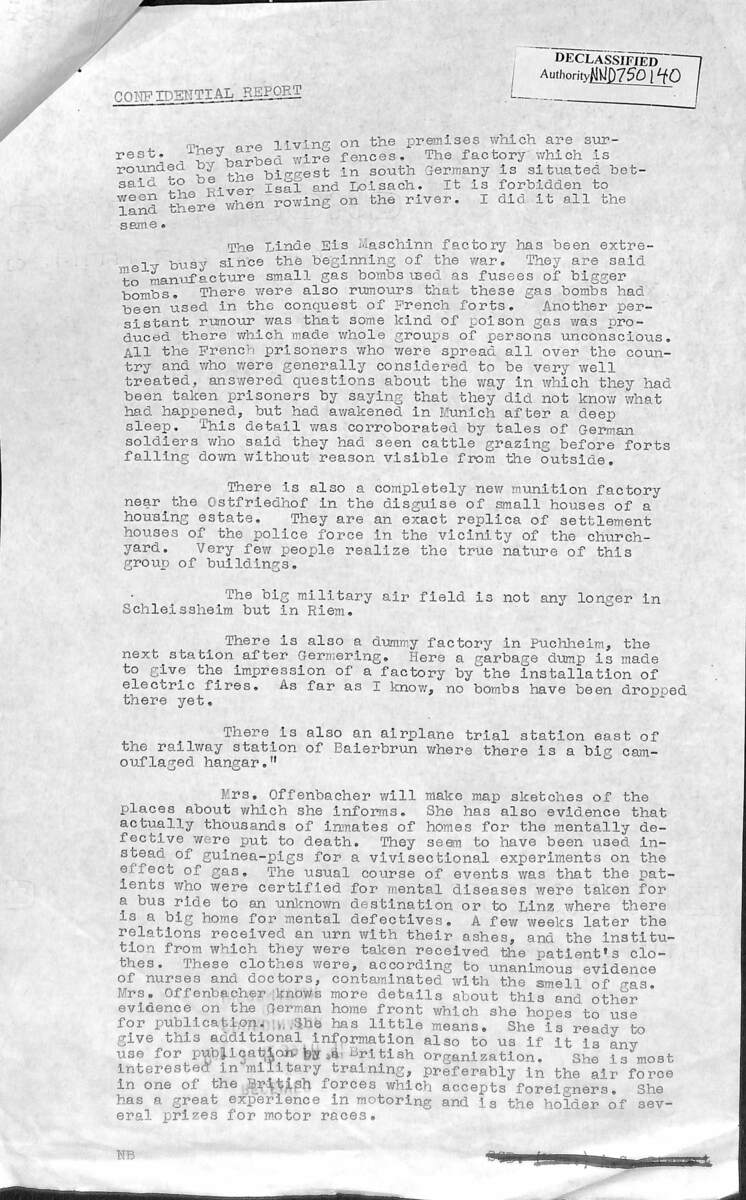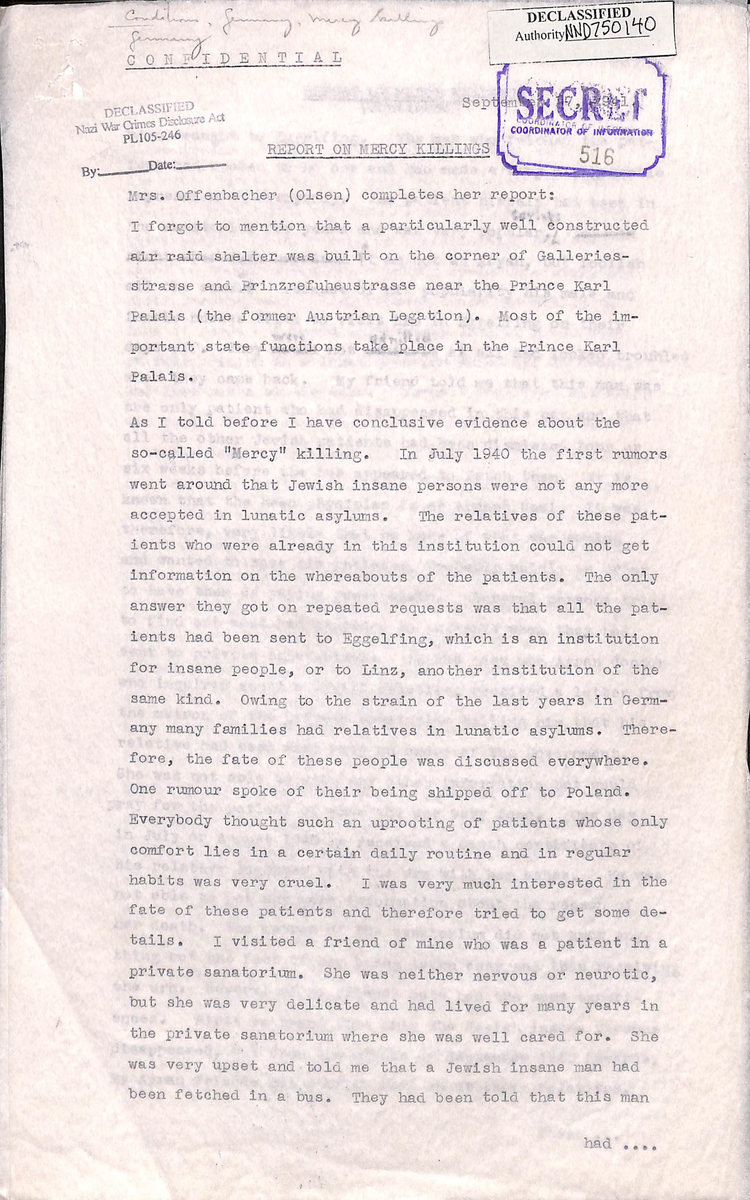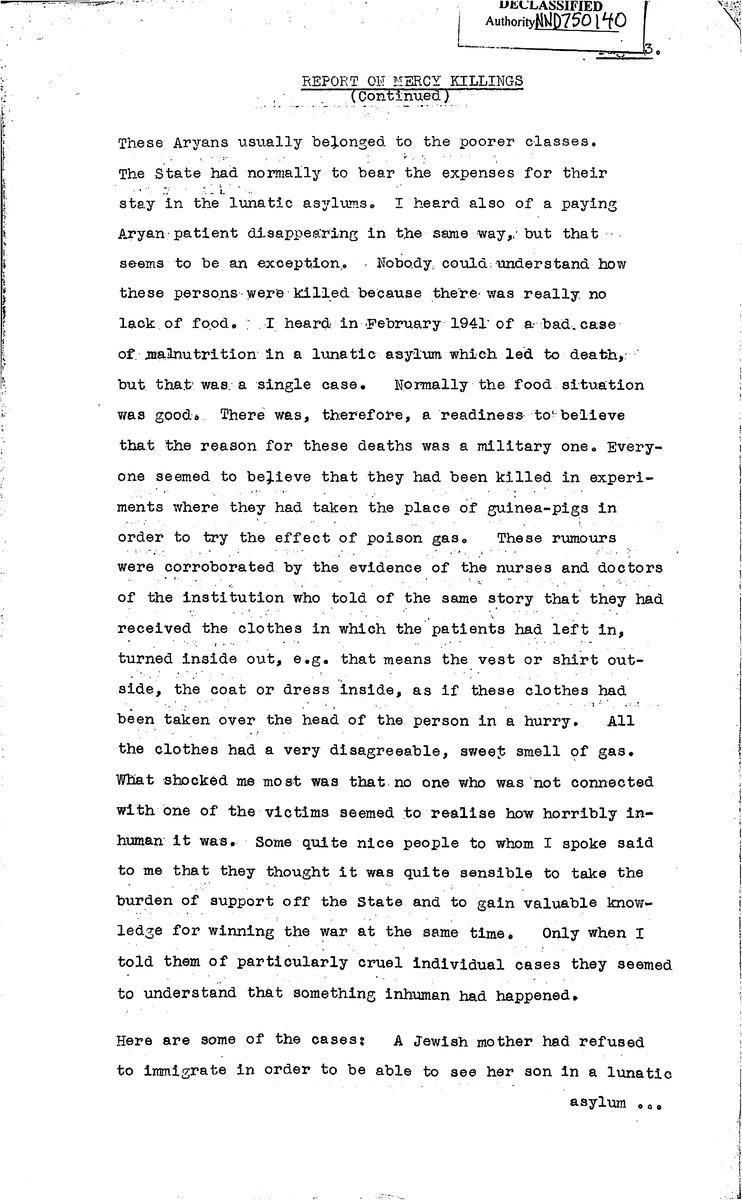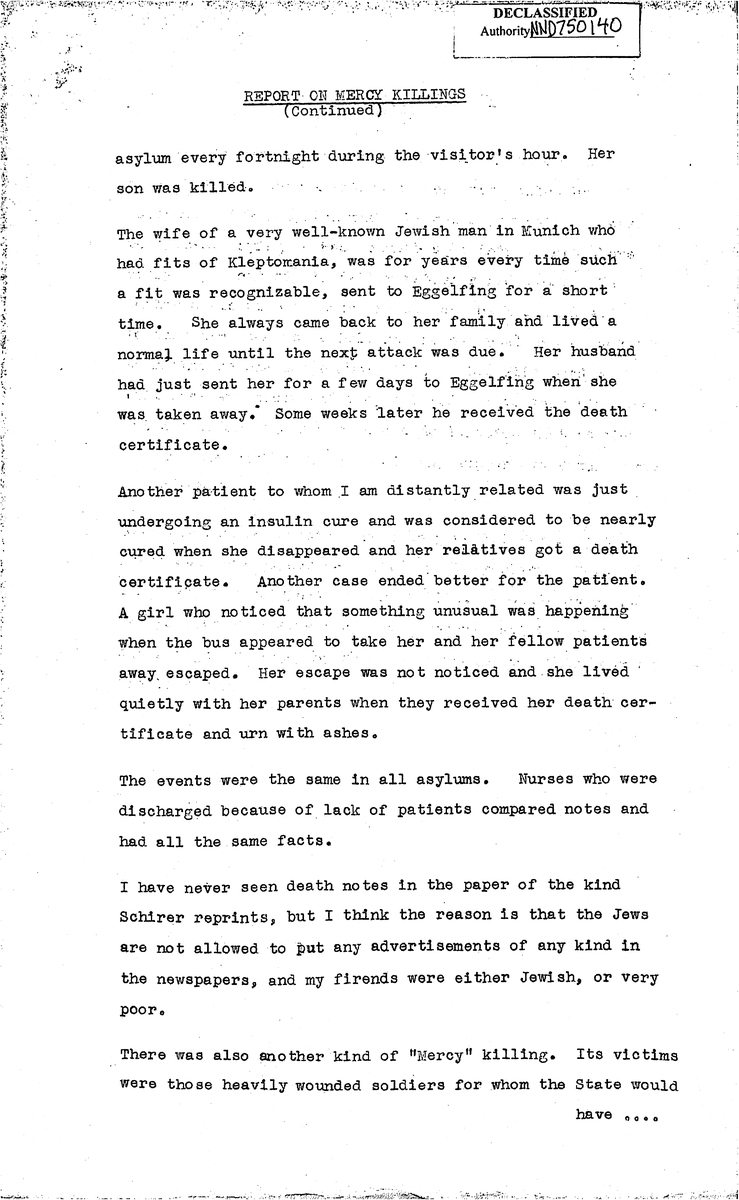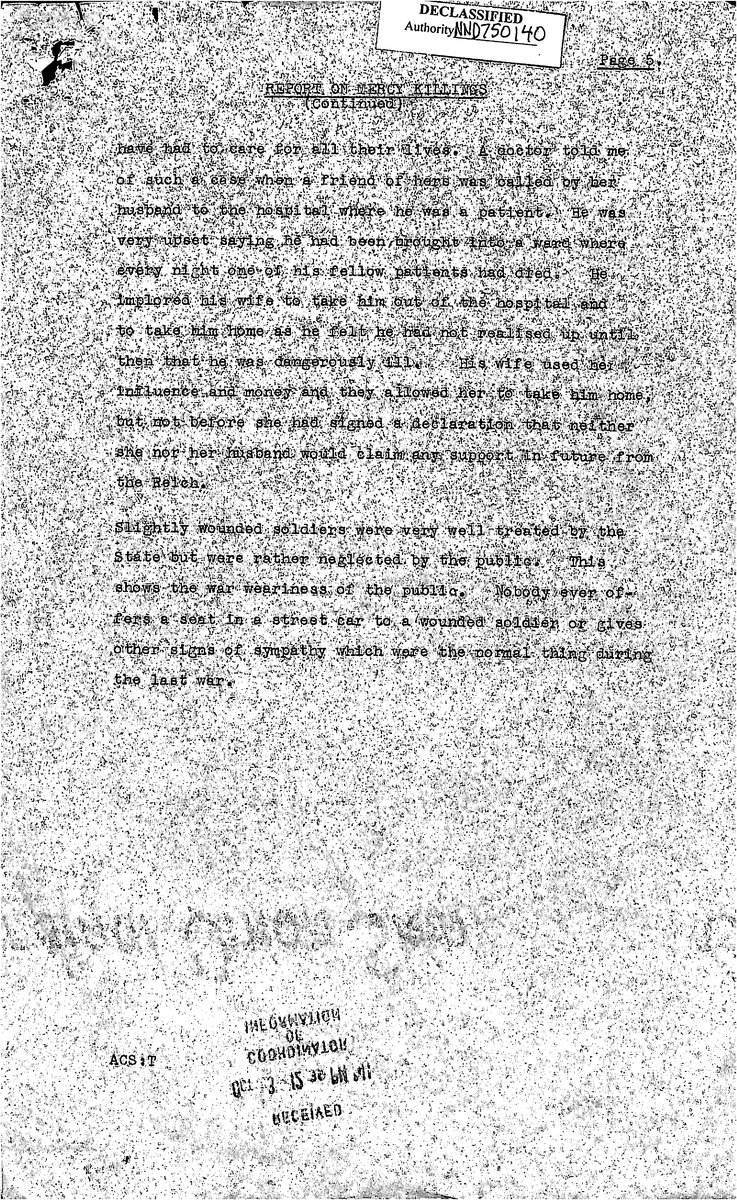Source
CONFIDENTIAL
REPORT
Mrs. Lily Offenbacher, 4802 43rd Street, Woodside, Long Island City, is a Jewish widow of a man who was connected with Der Gerade Weg, a Catholic newspaper in Munich, edited by Dr. Fritz Gerlich and supported by the Jesuits and in strong opposition to the Nazis in 1932–1933. It was, therefore, the object of an immediate attack when the Nazis came into power in March 1933. Dr. Gerlich was murdered in prison.
Mrs. Offenbacher has been recommended to us by Mr. Fluegge and was interviewed by Mrs. Stewart. She seems very reliable and her statements seem to be correct. She herself is still rather nervous as she had been in prison shortly before she left Germany. She gives the following information:
“I left Germany in June. I went to Lisbon by airplane and continued the journey by boat. I could not leave Germany before because I had to nurse my sick mother who died in the meantime. I also wanted to bring my aged father with me and we had endless difficulties with our passports.
During the last two years I have continually tried to get information about German war industries. I have reliable information about Munich and its surroundings. I think my information might be valuable for the R.A.F. because during the air attacks on Munich last August and September and again on the 8th of November not a single military object was hit. I have learned since that there were reports outside Germany that the attack was intended for the B.M.W.; if such a plan existed, it failed completely. The objectives hit included: the restaurant Baurngirgl; the residential section in the center of the town; the house of an iron monger, Dandl, whose house is opposite the Sterneckerbrau where the Nazi party had its first meeting place. If the Brau was the aim it was a close miss. In Munich several bombs fell in the Englischer Garten and the Bavaria Ring.
The most important places besides the B.M.W. (which seemed not to be camouflaged at all) are the big munitions factory in Wolfratshausen; the Linde Eis Maschinerie factory, Hoellriegelskreuth, both in Isartal south of Munich and the new factory at the Ostfriedhof and, last but not least, the big munition[s] factory Friderick Deckel in Mittel Sendling. The factory in Mittel Sendling makes important parts of guns and cannons, mainly mechanical springs, etc.
The Wolfratshausen factory was built in 1935 and is completely underground. Only railroads and cranes are on the surface and they are well hidden between the high trees of the surrounding woods. Workmen working there are mostly convicts released from the penitentiary after having served part of their sentence and being bound over for the rest. They are living on the premises which are surrounded by barbed wire fences. The factory which is said to be the biggest in south Germany is situated between the River Isal and Loisach. It is forbidden to land there when rowing on the river. I did it all the same.
The Linde Eis Maschinen factory has been extremely busy since the beginning of the war. They are said to manufacture small gas bombs used as fuses of bigger bombs. There were also rumors that these gas bombs had been used in the conquest of French forts. Another persistent rumor was that some kind of poison gas was produced there which made whole groups of persons unconscious. All the French prisoners, who were spread all over the country and who were generally considered to be very well treated, answered questions about the way in which they had been taken prisoner by saying that they did not know what had happened, but had awakened in Munich after a deep sleep. This detail was corroborated by tales of German soldiers who said they had seen cattle grazing before forts falling down without reason visible from the outside.
There is also a completely new munitions factory near the Ostfriedhof in the disguise of small houses of a housing estate. They are an exact replica of settlement houses of the police force in the vicinity of the churchyard. Very few people realize the true nature of this group of buildings.
The big military airfield is not any longer in Schleissheim but in Riem.
There is also a dummy factory in Puchheim, the next station after Germering. Here a garbage dump is made to give the impression of a factory by the installation of electric fires. As far as I know, no bombs have been dropped there yet.
There is also an airplane trial station east of the railway station of Baierbrun where there is a big camouflaged hangar.”
Mrs. Offenbacher will make map sketches of the places about which she informs. She also has evidence that actually thousands of inmates of homes for the mentally defective were put to death. They seem to have been used instead of guinea pigs for vivisectional experiments on the effect of gas. The usual course of events was that the patients who were certified for mental diseases were taken for a bus ride to an unknown destination or to Linz where there is a big home for mental defectives. A few weeks later the relations received an urn with their ashes, and the institution from which they were taken received the patient’s clothes. These clothes were, according to unanimous evidence of nurses and doctors, contaminated with the smell of gas. Mrs. Offenbacher knows more details about this and other evidence on the German home front which she hopes to use for publication. She has little means. She is ready to give this additional information also to us, if it is any use, for publication by a British organization. She is most interested in military training, preferably in the air force in one of the British forces which accepts foreigners. She has a great experience in motoring and is the holder of several prizes for motor races.
REPORT ON MERCY KILLINGS
Mrs. Offenbacher (Olsen) completes her report:
“I forgot to mention that a particularly well constructed air raid shelter was built on the corner of Galleriestrasse and Prinzregentenstrasse near the Prince Karl Palais (the former Austrian Legation). Most of the important state functions take place in the Prince Karl Palais.
As I told before I have conclusive evidence about the so-called ‘Mercy’ killing. In July 1940 the first rumors went around that Jewish insane persons were not any more accepted in lunatic asylums. The relatives of these patients who were already in this institution could not get information on the whereabouts of the patients. The only answer they got on repeated requests was that all the patients had been sent to Eggelfing, which is an institution for insane people, or to Linz, another institution of the same kind. Owing to the strain of the last years in Germany many families had relatives in lunatic asylums. Therefore, the fate of these people was discussed everywhere. One rumor spoke of their being shipped off to Poland. Everybody thought such an uprooting of patients whose only comfort lies in a certain daily routine and in regular habits was very cruel. I was very much interested in the fate of these patients and therefore tried to get some details. I visited a friend of mine who was a patient in a private sanatorium. She was neither nervous nor neurotic, but she was very delicate and had lived for many years in the private sanatorium where she was well cared for. She was very upset and told me that a Jewish insane man had been fetched in a bus. They had been told that this man been brought to Eggelfing. The man who fetched the patient had spoken to no one and had made a very disagreeable impression on everybody. The patient himself had been in the sanatorium for years and was very popular, saying: ‘I am not an Aryan, but foolish all the same.’ Because of his popularity his male and female nurses tried to visit him in Eggelfing on their days off. They were not admitted at all and looked troubled when they came back. My friend told me that this man was the only patient who had disappeared in this way and that all the other Jewish patients had been dismissed four or six weeks before the bus appeared to fetch them. It is known that the head physician is an ardent Nazi. It was, therefore, very likely that he knew of what was coming and wanted to save his patients, probably mainly in order to have them as paying guests again. Several persons tried to find out what had happened to patients whom they had sent to private sanatoriums. In one case, one Ayran doctor who inquired about a Jewish relative received a letter from the matron of the private sanatorium telling him that his relative had been sent away on order of the Government. She was not able to give any other information but would pray for the patient of whom she was very fond. One day in July or August 1940 he received a death certificate of his relative together with the urn with her ashes. He was not able to get any more information about the reason of her death. The matron of the sanatorium did not know anything but the fact of her being taken away and then receiving the urn. Several of my friends have had the same experiences. First we heard that only the Jewish insane persons disappeared, but from the middle of September 1940 onwards, my Ayran friends got similar news about their relatives. These Aryans usually belonged to the poorer classes. The State had normally to bear the expenses for their stay in the lunatic asylums. I heard also of a paying Aryan patient disappearing in the same way, but that seems to be an exception. Nobody could understand how these persons were killed because there was really no lack of food. I heard in February 1941 of a bad case of malnutrition in a lunatic asylum which led to death, but that was a single case. Normally the food situation was good. There was, therefore, a readiness to believe that the reason for these deaths was a military one. Everyone seemed to believe that they had been killed in experiments where they had taken the place of guinea pigs in order to try the effect of poison gas. These rumors were corroborated by the evidence of the nurses and doctors of the institution who told of the same story that they had received the clothes in which the patients had left in, turned inside out, e.g., that means the vest or shirt outside, the coat or dress inside, as if these clothes had been taken over the head of the person in a hurry. All the clothes had a very disagreeable, sweet smell of gas. What shocked me most was that no one who was not connected with one of the victims seemed to realize how horribly inhuman it was. Some quite nice people to whom I spoke said to me that they thought it was quite sensible to take the burden of support off the State and to gain valuable knowledge for winning the war at the same time. Only when I told them of particularly cruel individual cases they seemed to understand that something inhuman had happened.
Here are some of the cases: A Jewish mother had refused to emigrate in order to be able to see her son in a lunatic asylum every fortnight during the visitor’s hour. Her son was killed.
The wife of a very well-known Jewish man in Munich who had fits of kleptomania was, for years every time such a fit was recognizable, sent to Eggelfing for a short time. She always came back to her family and lived a normal life until the next attack was due. Her husband had just sent her for a few days to Eggelfing when she was taken away. Some weeks later he received the death certificate.
Another patient to whom I am distantly related was just undergoing an insulin cure and was considered to be nearly cured when she disappeared, and her relatives got a death certificate. Another case ended better for the patient. A girl who noticed that something unusual was happening when the bus appeared to take her and her fellow patients away escaped. Her escape was not noticed and she [was living] quietly with her parents when they received her death certificate and urn with ashes.
The events were the same in all asylums. Nurses who were discharged because of lack of patients compared notes and had all the same facts.
I have never seen death notes in the paper of the kind Schirer reprints, but I think the reason is that the Jews are not allowed to put any advertisements of any kind in the newspapers, and my friends were either Jewish, or very poor.
There was also another kind of ‘Mercy’ killing. Its victims were those heavily wounded soldiers for whom the State would have had to care for all their lives. A doctor told me of such a case when a friend of hers was called by her husband to the hospital where he was a patient. He was very upset saying he had been brought into a ward where every night one of his fellow patients had died. He implored his wife to take him out of the hospital and to take him home as he felt he had not realized up until then that he was dangerously ill. His wife used her influence and money and they allowed her to take him home, but not before she had signed a declaration that neither she nor her husband would claim any support in future from the Reich.
Slightly wounded soldiers were very well treated by the State but were rather neglected by the public. This shows the war weariness of the public. Nobody ever offers a seat in a streetcar to a wounded soldier or gives other signs of sympathy which were the normal thing during the last war.”
Source: Lily Offenbacher Shares Her Knowledge of the Euthanasia
Program with the U.S. Coordinator of Information (September 1941),
U.S. National Archives and Records Administration, College Park,
MD, Record Group 226, Entry 16, Box 3, Documents 514 and
516.
Original document is in English.
